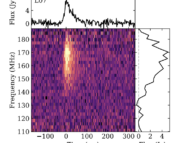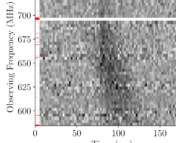Title: Probing the distant universe with a very luminous fast radio burst at redshift 1
Authors: Stuart D.Ryder, Keith W. Bannister, S. Bhandari, A. T. Deller, R. D. Ekers, Marcin Glowacki, Alexa C. Gordon, Kelly Gourdji, C. W. James, Charles D. Kilpatrick, Wenbin Lu, Lachlan Marnoch, V. A. Moss, J. Xavier Prochaska, Hao Qiu, Elaine M. Sadler, Sunil Simha, Mawson W. Sammons, Danica R. Scott, Nicolas Tejos, R. M. Shannon
First Author’s Institution: Macquarie University, Sydney, Australia
Status: Science [Submitted]
June 6, 2022. It’s a beautiful summer night. The grass is rustling, and the sky is clear as can be. You decide tonight that you want to use your newly bought radio goggles to try to see some radio emission. You walk out to your porch, put on your goggles, and take a seat. At that moment, you see a bright, fast, point-like flash of radio emission. What might it be? Your goggles are processing…. “FRB” it reads. Fast radio bursts (FRBs) are super short (think milliseconds or nanoseconds) and bright (think all the power of the sun emitted in a millisecond) bursts of radio emission coming from other galaxies. “Wow!”, you think to yourself. What you don’t know is that you just saw an FRB 8 billion light years away. Seems far? That’s because it is!
Now, while radio goggles aren’t yet a reality, an FRB was detected on June 6, 2022 from a distance of 8 billion light years away (equal to a cosmological redshift of 1). This is one of the farthest (if not the farthest) FRBs detected yet! Today’s authors present the discovery of this FRB, along with some of its rare (and slightly surprising) properties. Let’s dig in.
Initial discovery and localization
Today’s FRB was found using the Australian Square Kilometre Array Pathfinder (ASKAP; see Figure 1 below). ASKAP is a radio interferometer consisting of 36 twelve-meter antenna dishes. A radio interferometer is a type of radio telescope in which the signals from the different antennas are correlated to create one telescope with an uber large diameter (e.g., equal to the distance between all the dishes). One of the beauties of ASKAP and its interferometry network is that it can localize (i.e., pinpoint the location of) FRBs to around a few tenths of an arcsecond (that’s 0.0002 degrees!).
Given a localization accuracy of 0.5 arcsec, today’s authors are able to localize today’s FRB (which goes by the name of FRB 20220610A) to a rather complex host galaxy at a redshift of 1. As shown below in Figure 1, the FRB is located in a galaxy that is merging with another galaxy! Of the two merging galaxies, the FRB’s galaxy seems to host an older stellar population that emits more than the other galaxy in the Ks-band.
Super far, and super energetic!
Next, before we continue on, let’s take a bit of a step back and review a fundamental relation of FRB science: the Macquart relation. Using an initial sample of eight FRBs, J.P. Macquart (and others) showed that there was a strong correlation between the cosmic (e.g., not due to our Galaxy) dispersion measure of a given FRB and its host galaxy redshift. As a quick review, the dispersion measure is just the total free electron content between you and a given source, while the redshift is a proxy for distance. So, you might expect the two to be correlated e.g., the farther out we go, the more stuff we encounter! The results initially presented by Macquart et al. (2020) aligned well with the predictions made using data from Planck 2015 measurements of the cosmic microwave background (CMB) e.g., see Figure 3 below.
Now, where does today’s FRB come in? Well, today’s FRB has an extremely high DM of ~1500 pc cm-3. Given today’s authors also know the redshift of the galaxy that the FRB is associated with, they are able to add their FRB to the original Macquart plot, and extend the Macquart relation to even higher redshifts (e.g., see Figure 3 above). They show that even out to redshifts of ~1, the gas remains highly ionized (this comes from the fact that the free electrons that the DM measures were kicked out of their atoms, and left behind a bunch of ionized gas). However, the estimated FRB’s DM not due to the Milky Way (the cosmic portion) is a bit larger than that which is predicted by the Macquart relation. This excess could be due to the host galaxy itself, or possible foreground objects such as galaxy halos.
Given the known distance to this FRB, today’s authors are able to calculate its total energy to be ~6 x 1032 erg Hz-1. While this number might seem a bit abstract, it is higher than the predicted maximum energy for FRBs! This brings into question all of the current FRB models, along with FRB population studies which have predicted and/or assumed maximum energies less than this.
While it is possible that this is a highly rare event e.g., at the very tippy top of the energy distribution, this seems pretty unlikely, given this was just a random FRB that they detected. So it looks like we might need to rethink our models and our population studies to get ready for more high-DM, high-energy bursts.
Astrobite edited by Zili Shen
Featured image credit: OzGrav, Swinburne University of Technology






